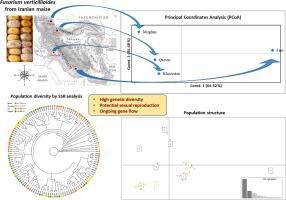Fungal Genetics and Biology ( IF 3 ) Pub Date : 2021-07-29 , DOI: 10.1016/j.fgb.2021.103613 Maryam Fallahi 1 , Stefania Somma 2 , Mohammad Javan-Nikkhah 1 , Hossein Saremi 1 , Gaetano Stea 3 , Mario Masiello 2 , Antonio F Logrieco 2 , Antonio Moretti 2

|
Fusarium verticillioides is one of the most important fungal pathogens of maize since it causes severe yield losses and produces the mycotoxins fumonisins that represent a major concern for human and animal health. Information about genetic diversity and population structure of fungal pathogens is essential for developing disease management strategies. The aim of this research was to investigate the genetic structure of F. verticillioides isolated from different provinces of Iran through determination of mating type idiomorphs, phylogenetic analyses based on translation elongation factor-1 alpha (EF-1α), RNA Polymerase II Subunit (RPB2), beta-tubulin (tub2) and Calmodulin (cmdA) genes and genetic diversity analyses based on 6 simple-sequence repeats (SSRs). Both mating types were detected in Iranian populations of F. verticillioides, particularly in Qazvin and Khuzestan, with equal frequency, which highlighted that sexual reproduction is favorable under field conditions. However, the linkage disequilibrium indices did not support the hypothesis of random mating in Khuzestan and Fars. Although assessment of nucleotide diversity based on housekeeping genes showed low level of variation among strains, genotype diversity based on SSRs revealed a high level of genetic diversity within Iranian populations. AMOVA analysis highlighted that the genetic variation of F. verticillioides in Iran was mainly distributed within population of a single area (97%), while a small proportion of genetic variation (3%) resided among populations. These patterns of variation are likely explained by the continuous gene flow among populations isolated from different areas. On the other hand, principal coordinate analysis indicated that the distribution of genetic variation among populations could be explained by the geographical distances. Consequently, to reduce pathogen gene flow among regions, the quarantine processes in Iran should be intensified.
中文翻译:

伊朗玉米轮枝镰孢菌群的遗传结构
Fusarium verticillioides是玉米最重要的真菌病原体之一,因为它会导致严重的产量损失并产生代表人类和动物健康的主要问题的霉菌毒素伏马菌素。有关真菌病原体的遗传多样性和种群结构的信息对于制定疾病管理策略至关重要。本研究的目的是通过确定交配型异形体、基于翻译延伸因子-1 α ( EF-1α )、RNA 聚合酶 II亚基( RPB2 ), β-微管蛋白( tub2) 和钙调素( cmdA ) 基因和基于 6 个简单序列重复 (SSR) 的遗传多样性分析。这两种交配类型均在伊朗轮枝菌种群中检测到,特别是在加兹温和胡齐斯坦,频率相同,这表明有性生殖在田间条件下是有利的。然而,连锁不平衡指数不支持胡齐斯坦和法尔斯随机交配的假设。尽管基于看家基因的核苷酸多样性评估显示菌株之间的变异水平较低,但基于 SSR 的基因型多样性揭示了伊朗人群中的高水平遗传多样性。AMOVA 分析强调F. verticillioides的遗传变异在伊朗,主要分布在单一地区的人群中(97%),而一小部分遗传变异(3%)存在于人群中。这些变异模式很可能是由从不同地区隔离的种群之间的连续基因流动来解释的。另一方面,主坐标分析表明,种群间遗传变异的分布可以用地理距离来解释。因此,为了减少区域之间的病原体基因流动,伊朗应该加强检疫程序。


























 京公网安备 11010802027423号
京公网安备 11010802027423号